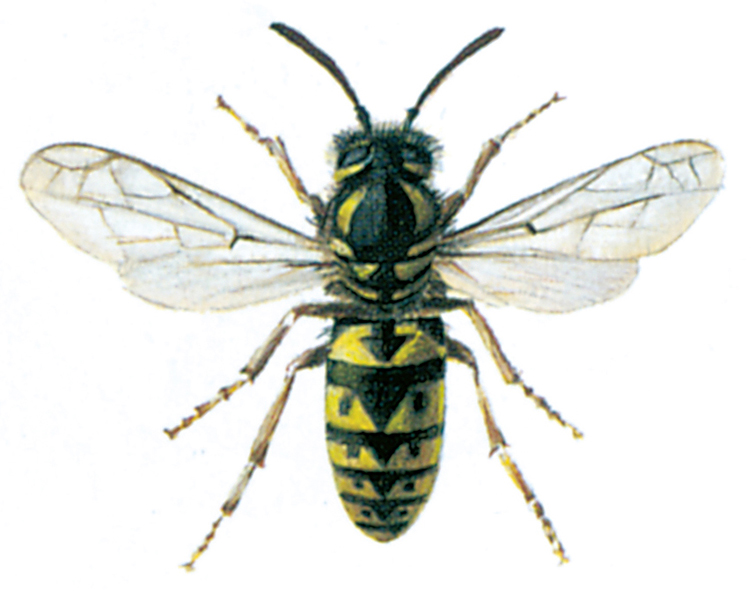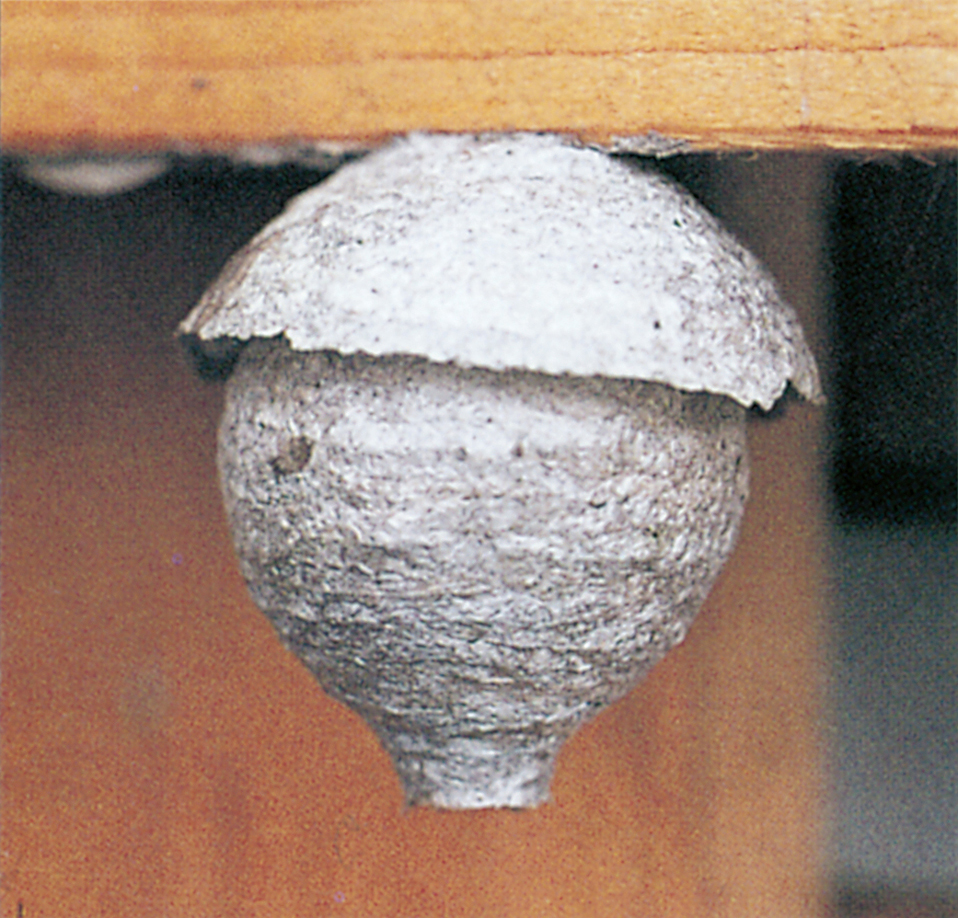(Latin: Superfamily Vespoidea)

There are seven different species of social wasp in Britain and northern Europe, and they all have the same general appearance with the black-yellow barring, and the same habits. The wasps usually seen in or near houses are the common wasp Vespula vulgaris, the German wasp, Vespula germanica, and the hornet Vespa erabro.
In social wasps, as in many bees and ants, the characteristic feature is a division of labour within the colony. Among the wasps the queens and males are occupied with reproduction while the workers build the nest, feed the larvae and defend the colony. Worker wasps are actually females with undeveloped reproductive organs.
Unlike the honey bee, wasps have not developed methods of storing food for the winter, and in temperate regions their colonies only last for one season. Each colony starts to break up in the autumn, and the workers die of cold.
However, before this happens new queens and males develop and these swarm out of the colony to mate. The males die soon after mating, but the young, fertilised females search for a sheltered spot where they can spend the winter. Such dormant queens can often be found during the winter in lofts or outhouses.

The queens normally emerge from their winter quarters in mid-April and each one starts to search for a suitable site for its future colony. This may be a cavity in a wall, in a loft or under the eaves of a house. The queen starts the colony by building a spherical cell about the size of a walnut. Inside this she constructs 10 -20 hexagonal cells and lays an egg in each. The eggs have to be attached firmly be- cause each cell has its opening facing downwards. As soon as the eggs have hatched the queen is kept busy fetching food for the larvae, and after about a month (end of May) the first adult workers emerge from their pupae. The queen can now concentrate on egg-laying, while the workers take over the care of the larvae and the enlargement of the nest. Later in summer a successful wasp colony may hold 5.000-6.000 individuals.
Wasps can often be seen sitting on fences or telephone poles gnawing the timber. They chew the fine wood splinters with their own saliva to form a superior paper with which they construct the nest, both the outer protective casing, which comes to resemble an oval football and also the hexagonal cells in which the larvae develop.
The larvae have an exclusively animal diet, consisting mainly of flies and moths which the workers can catch in the air. The wings of the prey are cut off by the workers’ powerful mouthparts and the remains are divided up and chewed into round food balls, which are carried home to the larvae.
The workers themselves feed on liquid food. They can be seen drinking nectar from flowers and the juices of ripe fruit, and curiously enough they are also fed by the larvae. In exchange for fly flesh the larvae regurgitate a sugary liquid which the workers eagerly lick up. In addition to providing the workers with a form of energy this mutual feeding also has a social function, as it serves to bind the colony together.

During most of the summer, therefore, the worker wasps are kept busy maintaining the colony, and one sees surprisingly little of them, even when they have a colony in the house. By late summer, however, they stop rearing larvae and start to move around in search of sweet sub- stances, and this is when they are noticed. They are usually just an annoyance but they can be a serious problem in bakeries, fruiterers and other food establishments.
In private house, wasps are noticed particularly when jam is being made and during picnics. As they also visit carrion, dustbins and similar places they, like houseflies, may possibly spread disease.
They can also, of course, sting (p. 50) and in certain cases it may be advisable to exterminate a wasp colony when it has been built actually in part of the house. There are several ways of doing this, and two will be mentioned here. It is always best to undertake this task in the evening when all the members of the colony have returned home; also wasps are not so aggressive in the dark and when the temperature falls in the evening. If the nest happens to be in a place where it would be safe to set it on fire, then this would naturally be the quickest and most effective method of destruction. Alternatively, the nest can be carefully treated with an insecticidal powder, which should be blown into the entrance hole from below. In cases where the nest itself is inaccessible the powder should be blown into the cracks and crevices used by the wasps when flying in and out of the nest. It is not a good idea to stop up these holes, as the wasps are then quite likely to find their way into the house. In cases where a house proves to be a favourite nesting site for wasps it is always advisable to inspect it early in the summer and to destroy any nests before they become too large.
Light traps (p. 217) can be effective in catching wasps, e.g. in bakeries and food factories.




